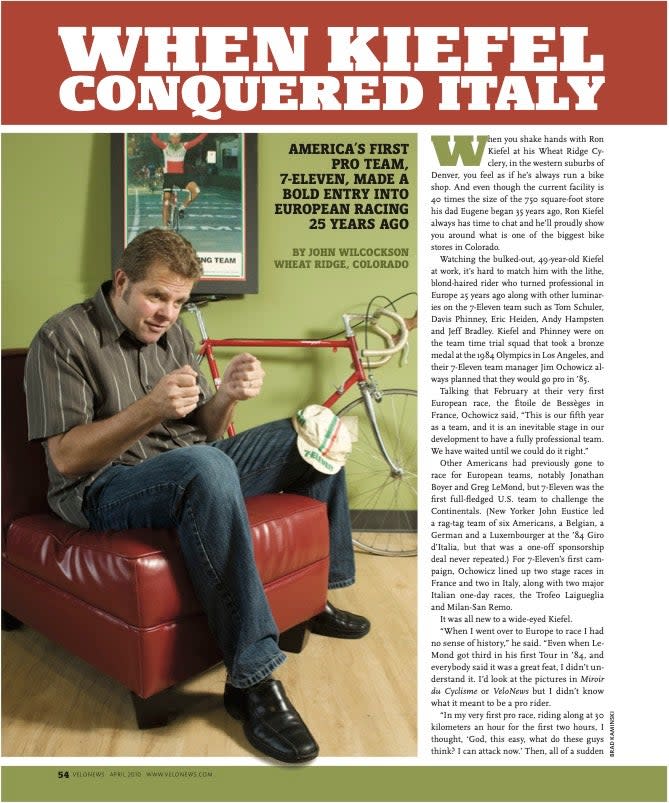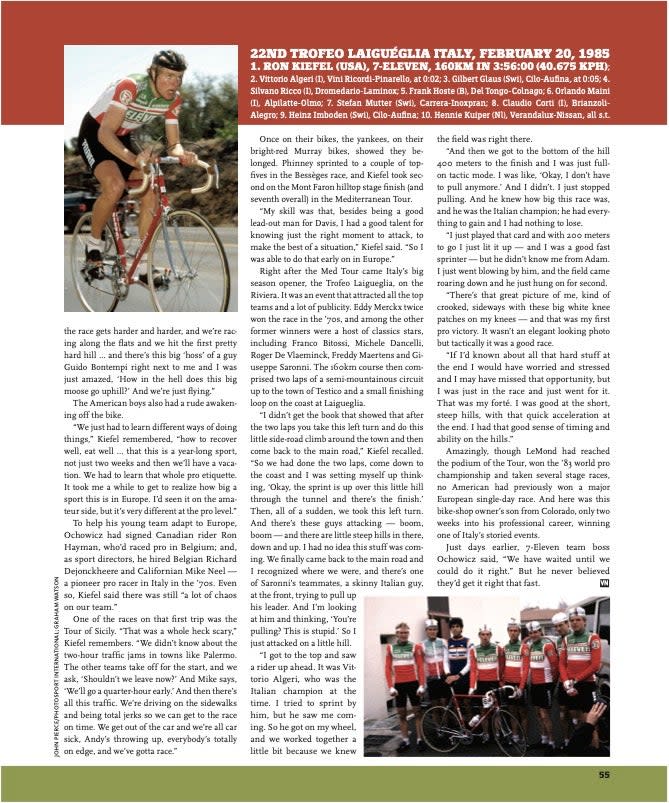VeloNews Archives: When Kiefel conquered Italy
This article originally appeared on Velo News
In April 2010, VeloNews took a look back at the then 25th anniversary of the 7-Eleven team’s bold entry into European racing. Story by John Wilcockson and lead image by Brad Kaminski.
When you shake hands with Ron Kiefel at his Wheat Ridge Cyclery, in the western suburbs of Denver, you feel as if he's always run a bike shop. And even though the current facility is 40 times the size of the 750 square-foot store his dad Eugene began 35 years ago, Ron Kiefel always has time to chat and he'll proudly show you around what is one of the biggest bike stores in Colorado.
Watching the bulked-out, 49-year-old Kiefel at work, it's hard to match him with the lithe, blond-haired rider who turned professional in Europe 25 years ago along with other luminaries on the 7-Eleven team such as Tom Schuler, Davis Phinney, Eric Heiden, Andy Hampsten and Jeff Bradley. Kiefel and Phinney were on the team time trial squad that took a bronze medal at the 1984 Olympics in Los Angeles, and their 7-Eleven team manager Jim Ochowicz always planned that they would go pro in '85.
Talking that February at their very first European race, the Etoile de Besseges in France, Ochowicz said, "This is our fifth year as a team, and it is an inevitable stage in our development to have a fully professional team. We have waited until we could do it right."
Also read: Bobby & Jens: American cycling pioneer Ron Kiefel looks back on his 7-Eleven days
Other Americans had previously gone to race for European teams, notably Jonathan Boyer and Greg LeMond, but 7-Eleven was the first full-fledged U.S. team to challenge the Continentals. (New Yorker John Eustice led a rag-tag team of six Americans, a Belgian, a German and a Luxembourger at the '84 Giro d'Italia, but that was a one-off sponsorship deal never repeated.) For 7-Eleven's first campaign, Ochowicz lined up two stage races in France and two in Italy, along with two major Italian one-day races, the Trofeo Laigueglia and Milan-San Remo.
It was all new to a wide-eyed Kiefel.
"When I went over to Europe to race I had no sense of history," he said. "Even when LeMond got third in his first Tour in '84, and everybody said it was a great feat, I didn't understand it. I'd look at the pictures in Miroir du Cyclisme or VeloNews but I didn't know what it meant to be a pro rider.

"In my very first pro race, riding along at 30 kilometers an hour for the first two hours, I thought, 'God, this easy, what do these guys think? I can attack now.' Then, all of a sudden the race gets harder and harder, and we're rac- ing along the flats and we hit the first pretty hard hill … and there's this big 'hoss' of a guy Guido Bontempi right next to me and I was just amazed, 'How in the hell does this big moose go uphill?' And we're just flying."
The American boys also had a rude awakening off the bike.
"We just had to learn different ways of doing things," Kiefel remembered, "how to recover well, eat well … that this is a year-long sport, not just two weeks and then we'll have a vacation. We had to learn that whole pro etiquette. It took me a while to get to realize how big a sport this is in Europe. I'd seen it on the amateur side, but it's very different at the pro level."
To help his young team adapt to Europe, Ochowicz had signed Canadian rider Ron Hayman, who'd raced pro in Belgium; and, as sport directors, he hired Belgian Richard Dejonckheere and Californian Mike Neel -- a pioneer pro racer in Italy in the '70s. Even so, Kiefel said there was still "a lot of chaos on our team."
One of the races on that first trip was the Tour of Sicily. "That was a whole heck scary," Kiefel remembers. "We didn't know about the two-hour traffic jams in towns like Palermo. The other teams take off for the start, and we ask, 'Shouldn't we leave now?' And Mike says, 'We'll go a quarter-hour early.' And then there's all this traffic. We're driving on the sidewalks and being total jerks so we can get to the race on time. We get out of the car and we're all car sick, Andy's throwing up, everybody's totally on edge, and we've gotta race."
Once on their bikes, the yankees, on their bright-red Murray bikes, showed they belonged. Phinney sprinted to a couple of top- fives in the Besseges race, and Kiefel took second on the Mont Faron hilltop stage finish (and seventh overall) in the Mediterranean Tour.
"My skill was that, besides being a good lead-out man for Davis, I had a good talent for knowing just the right moment to attack, to make the best of a situation," Kiefel said. "So I was able to do that early on in Europe."
Right after the Med Tour came Italy's big season opener, the Trofeo Laigueglia, on the Riviera. It was an event that attracted all the top teams and a lot of publicity. Eddy Merckx twice won the race in the '70s, and among the other former winners were a host of classics stars, including Franco Bitossi, Michele Dancelli, Roger De Vlaeminck, Freddy Maertens and Giuseppe Saronni. The 160km course then comprised two laps of a semi-mountainous circuit up to the town of Testico and a small finishing loop on the coast at Laigueglia.
"I didn't get the book that showed that after the two laps you take this left turn and do this little side-road climb around the town and then come back to the main road," Kiefel recalled. "So we had done the two laps, come down to the coast and I was setting myself up thinking, 'Okay, the sprint is up over this little hill through the tunnel and there's the finish.' Then, all of a sudden, we took this left turn. And there's these guys attacking -- boom, boom -- and there are little steep hills in there, down and up. I had no idea this stuff was coming. We finally came back to the main road and I recognized where we were, and there's one of Saronni's teammates, a skinny Italian guy, at the front, trying to pull up his leader. And I'm looking at him and thinking, 'You're pulling? This is stupid.' So I just attacked on a little hill.

"I got to the top and saw a rider up ahead. It was Vittorio Algeri, who was the Italian champion at the time. I tried to sprint by him, but he saw me coming. So he got on my wheel, and we worked together a little bit because we knew the field was right there."And then we got to the bottom of the hill 400 meters to the finish and I was just full-on tactic mode. I was like, 'Okay, I don't have to pull anymore.' And I didn't. I just stopped pulling. And he knew how big this race was, and he was the Italian champion; he had everything to gain and I had nothing to lose.
"I just played that card and with 200 meters to go I just lit it up--and I was a good fast sprinter -- but he didn't know me from Adam. I just went blowing by him, and the field came roaring down and he just hung on for second.
"There's that great picture of me, kind of crooked, sideways with these big white knee patches on my knees -- and that was my first pro victory. It wasn't an elegant looking photo but tactically it was a good race.
"If I'd known about all that hard stuff at the end I would have worried and stressed and I may have missed that opportunity, but I was just in the race and just went for it. That was my forte. I was good at the short, steep hills, with that quick acceleration at the end. I had that good sense of timing and ability on the hills."
Amazingly, though LeMond had reached the podium of the Tour, won the '83 world pro championship and taken several stage races, no American had previously won a major European single-day race. And here was this bike-shop owner's son from Colorado, only two weeks into his professional career, winning one of Italy's storied events.
Just days earlier, 7-Eleven team boss Ochowicz said, "We have waited until we could do it right." But he never believed they'd get it right that fast.
For exclusive access to all of our fitness, gear, adventure, and travel stories, plus discounts on trips, events, and gear, sign up for Outside+ today.
